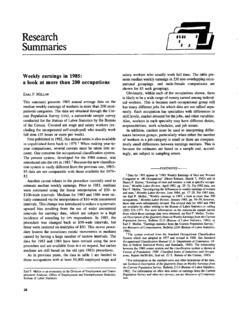Transcription of Average Earnings and Retail Prices, UK, 1209-2017
1 Average Earnings and Retail Prices, UK, 1209-2017 Gregory Clark, University of California, Davis 4-28-2018 This paper contains an explanation of the estimate of Average Earnings , and Retail prices for the UK, Britain or England in the years 1209-2017 displayed on the Measuring Net Worth website. Average Earnings , 1963-2017 Average weekly Earnings 1963-2017 of full time salaried workers in Great Britain (England, Scotland and Wales) are given by the UK Office of National Statistics (ONS). From 2000 on this is the index of Average Weekly Earnings (AWE), which includes bonuses and arrears for all jobs in the economy.
2 These are gross wages (before tax, national insurance or other deductions) for full time employees. The series used is KAC4. Because the wages here include all wage earners, not just manual workers, the series covers an array of middle and even upper class workers. When I calculate Earnings in the pre-industrial economy I thus also calculate an index for all labor income. Great Britain now constitutes 97 percent of UK population. To make these into annual Earnings I assume each worker was paid over 52 weeks of the year. For 1963-2000 the index used is the National Average Earnings Index (AEI), linked to this later index.
3 The Office of National Statistics reports that the main difference between these two indexes is that the AWE allows for changes in the composition of the labor force, while the AEI had fixed weights for different employment sectors. The treatment of bonus payments also changed over time. These were not recorded before 1996, and the way they were incorporated changed in 1999. The specific series used is LNMM. This series is obtained by request from the ONS for dates earlier than 1990. To merge this series with the one used from 2000 on one has to convert this index to levels.
4 The AEI series used here has 2000=100. Since we have a level of Average Earnings for 2000 from above it is easy to convert the index to levels by multiplying the series by the level value and dividing by 100. Average Earnings , 1870-1962 We shall see below the description of the wage series for England used for 1209-1869. To interpolate between these two Earnings series for the 103 years 1870-1962 I use the day wages of English building workers reported in Clark (2005). Even though the building wage series is for a standard day of 10 hours, and so does not allow for reductions in both hours per day, and days per year, between the 1860-9 and 1963-9 Average nominal wage Earnings rise nearly 20 percent more than builder s To allow for this I augment the nominal builder s wages with an additional growth rate of.
5 18 percent per year 1870-1962 in the interpolation, to allow for the growth in numbers of higher-earning salaried workers such as teachers, accountants, attorneys and the like. This is obviously a rough and ready procedure. But it does show some important trends in real Earnings in this era. The decline in real Earnings in WWI and WWII, and the rise in real wages in the Great Depression of the 1930s and the short sharp earlier recession of 1920-21. Average Earnings , 1209-1869 Average Earnings 1209-1869 are calculated for England, which is now 84 percent of the UK population.
6 For the earlier years I start with a benchmark in 1866. Leone Levi estimated the Average adult male wage in England in 1866 as 45 d. per day (Levi, 1867, 9). Levi also estimated the numbers of boys, women and girls at work, and their relative wages. As table 1 shows, this implies an Average wage per employed person of d. Assuming an annual number of days per year worked of 300, this implies Average yearly Earnings in 1866 of TABLE 1 To estimate aggregate labor income before 1209-1869, based on this benchmark, the approach here is to first estimate a separate national index of male farm day wages, male coal mining day wages, and male building wages (to represent both the secondary and tertiary sectors).
7 Then these are aggregated into a national male wage using estimates of the share of males employed in each sector. Women in 1851 and 1861 had Earnings about 25% of those of male workers: only about 50% as many list an occupation in the censuses, and their Average wage was about 50% that of men. It assumed throughout that women s Earnings thus constituted 25% of men s in the total of Earnings . It is shown that for the years 1820-1869 the Average national wage estimated on this basis correlates well with a 1 This is likely mainly from the changing composition of employment towards more high skilled technical and managerial positions over time.
8 Wage index with many more sectors such as cotton textiles, and shipbuilding, constructed by Feinstein (1998a, 1998b). 1. Farm Wage Index The details of the construction of the farm day wage index are given in Clark (2007). The wage estimated is the Average day wage of farm workers outside harvest. Farm workers typically earned extra income at hay time and the grain harvest. The Average premium at harvest (for 6 weeks) was 61%, and at hay (for 2 weeks) was 32%. Assuming a 300 day (50 week) year this implies that the Average day wage was greater than the level reported in table 2.
9 The reported Average male farm day wage reflects this adjustment. The prices and wages reported for the earlier years are frequently dated only by an account year which differs from a calendar year. Thus the most common account year in the medieval period ran from Michaelmas (29 September) to Michaelmas. This was because the harvest was complete only shortly before this quarter feast, and was the natural time for an account to be drawn of the success of the previous harvest season. Later parish accounts often ran from Lady Day (25th March) to Lady Day, or from Easter to Easter, where Easter had no fixed date.
10 In all cases where the exact date of a recorded wage or price is unknown it is attributed to the calendar year in which the majority of the account year falls. TABLE 2 2. Coal Wage Index Average day wages of male coal miners 1830-1869 are given by Church (1986). Wages 1740-1829 as estimated in the way described in Clark and Jacks (2007), assuming the majority of coal miners then were located in the north of England. Table 2 shows these wages by 10 year averages. 3. Building Worker Wages These are estimated as an Average of the day wages of skilled and unskilled building workers, as reported in Clark (2005).


